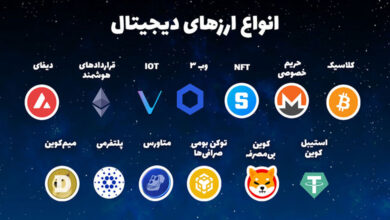Methods of Acquiring Cryptocurrencies: Mining, Buying, and Trading

Methods of Acquiring Cryptocurrencies: Mining, Buying, and Trading
Introduction
In recent years, methods of acquiring cryptocurrencies have become one of the most important tools for investment and exchange in the financial world. While many individuals and organizations are seeking to invest in this emerging market, there are various ways to obtain cryptocurrencies. Unlike traditional currencies, which are typically earned through work, investments, or trade, cryptocurrencies have different approaches for acquisition. From mining—which involves participating in transaction validation and network security—to purchasing cryptocurrencies through exchanges and trading in digital markets, each of these methods requires its own set of knowledge and equipment.
 Methods of Acquiring Cryptocurrencies
Methods of Acquiring Cryptocurrencies
This article examines the main methods of acquiring cryptocurrencies. First, we explain the process of mining cryptocurrencies and discuss its challenges and opportunities. Then, we discuss the purchase of cryptocurrencies through reputable exchanges, and finally, we introduce cryptocurrency trading as one method of profiting from market volatility.
Cryptocurrency Mining
Cryptocurrency mining is the process by which users utilize the computing power of their devices to validate cryptocurrency transactions and add them to the blockchain. As a reward for this work, they receive cryptocurrency. The first and most famous example of this process is the mining of Bitcoin, in which miners validate network transactions by solving complex mathematical problems.
Mining Algorithms
There are two main algorithms used for transaction validation in cryptocurrency mining:
- Proof of Work (PoW): In this algorithm, miners must solve complex mathematical problems. Bitcoin and Litecoin use this algorithm. One of the drawbacks of this method is its high energy consumption and the requirement for powerful hardware such as graphics cards (GPUs) or specialized integrated circuits (ASICs).
- Proof of Stake (PoS): In this method, individuals validate transactions based on the amount of cryptocurrency they hold (their stake). After the upgrade to version 2.0, Ethereum uses this algorithm. The advantage of this method over PoW is lower energy consumption and faster transaction speeds.
Resources Required for Mining
Mining cryptocurrencies requires specific resources, including:
- Powerful Hardware: For mining cryptocurrencies based on PoW, high computational power is needed.
- Electricity: Energy consumption is one of the major challenges in mining. For cryptocurrencies like Bitcoin, the energy consumption is very high, making mining economically unfeasible in some countries due to high electricity costs.
- Mining Software: Miners require software that connects their devices to the blockchain network. This software sends transactions to miners for validation.
 Methods of Acquiring Cryptocurrencies
Methods of Acquiring Cryptocurrencies
Mining Challenges
Mining cryptocurrencies faces several challenges, including:
- High Energy Consumption: Mining cryptocurrencies such as Bitcoin consumes a great deal of energy and incurs high costs.
- Mining Difficulty: As the number of miners and the network’s power increases, solving the increasingly complex mathematical problems becomes harder, thus intensifying the competition.
- Reduction in Mining Rewards: In some cryptocurrencies like Bitcoin, the mining reward is halved every few years (halving), which decreases the profitability of mining.
Buying Cryptocurrencies from Exchanges
One of the simplest and most common methods for acquiring cryptocurrency is to buy it directly via cryptocurrency exchanges. These exchanges are platforms that allow users to purchase various cryptocurrencies using fiat currencies (such as dollars and euros) or other cryptocurrencies.
Types of Cryptocurrency Exchanges
There are two main types of cryptocurrency exchanges:
- Centralized Exchanges (CEX): These exchanges are operated by centralized companies or entities and act as intermediaries. Users must create an account and store their cryptocurrencies in the exchange’s wallet. Examples of well-known centralized exchanges include Binance, Coinbase, and Kraken.
- Decentralized Exchanges (DEX): In these exchanges, there is no central governing body and users exchange cryptocurrencies directly with one another. Due to the elimination of intermediaries and the preservation of user privacy, these exchanges have gained significant popularity. Examples include Uniswap and SushiSwap.
The Process of Buying Cryptocurrencies
Purchasing cryptocurrencies through exchanges typically involves the following steps:
- Registration: Users need to create an account and usually complete a verification process.
- Depositing Funds: Users can fund their account by depositing fiat money or cryptocurrencies.
- Selecting a Cryptocurrency: Once the account is funded, users can choose the desired cryptocurrency to buy.
- Storing in a Wallet: Users can either store their purchased cryptocurrencies in an exchange wallet or transfer them to a personal wallet.
Advantages and Disadvantages of Buying from Exchanges
- Advantages:
- Speed and ease in buying cryptocurrencies.
- Access to a wide range of cryptocurrencies.
- Security and asset protection provided by the exchange (in reputable exchanges).
- Disadvantages:
- Dependence on a centralized exchange which may be vulnerable to hacks.
- High transaction fees on some exchanges.
- Regulations and restrictions in some countries may limit access to exchanges.
 Methods of Acquiring Cryptocurrencies
Methods of Acquiring Cryptocurrencies
Cryptocurrency Trading
Cryptocurrency trading, or trading, is another method of acquiring cryptocurrency that involves buying and selling digital currencies with the aim of profiting from their price fluctuations. In this method, users attempt to profit from market movements by buying at low prices and selling at high prices.
Types of Cryptocurrency Trading Methods
There are various approaches to trading cryptocurrencies:
- Day Trading: In this method, traders continuously buy and sell cryptocurrencies throughout the day, aiming to profit from small price changes. This approach requires extensive knowledge and experience.
- Swing Trading: In this method, traders hold cryptocurrencies for several days or weeks, seeking profit opportunities over a longer period.
- Position Trading: In this approach, traders hold cryptocurrencies for an extended period (several months or even years) to benefit from long-term value appreciation.
Tools and Platforms for Trading
Traders can use various platforms and tools for cryptocurrency trading:
- Trading Platforms: Centralized exchanges like Binance and Coinbase provide advanced tools for market analysis and executing trades.
- Technical Analysis Tools: Tools such as TradingView help traders analyze price charts and indicators to make better-informed decisions.
Trading Challenges and Risks
- High Volatility: Due to extreme price fluctuations in the cryptocurrency market, trading is very risky and investors can quickly gain or lose funds in a short period.
- Required Knowledge and Experience: Successful cryptocurrency trading requires market analysis and well-planned strategies. Novice traders may incur losses.
Investing in Cryptocurrencies
Investing in cryptocurrencies involves buying and holding digital currencies for a long period in order to profit from the long-term growth of the market. Unlike trading, which seeks profit from short-term fluctuations, investing relies on trusting the overall growth of the market over time.
Difference Between Investing and Trading
- Investing generally requires long-term analysis and patience, aiming to profit from asset value increases over several years.
- Trading usually involves short-term analysis and taking advantage of price fluctuations.
Key Points for Investors
- Risk Management: Investors should always allocate only a portion of their capital to cryptocurrencies and avoid investing all of their assets in this volatile market.
- Research and Analysis: Choosing cryptocurrencies for investment should be based on thorough research and analysis. Many cryptocurrencies may eventually exit the market in the long term.
Conclusion
There are various methods to acquire cryptocurrencies, each with its own advantages and disadvantages. From cryptocurrency mining, which requires specialized hardware and resources, to direct purchasing via exchanges and digital trading in markets, each method demands its own strategies and knowledge. Investors and users must carefully assess and choose the method that best suits their circumstances while managing the associated risks.







